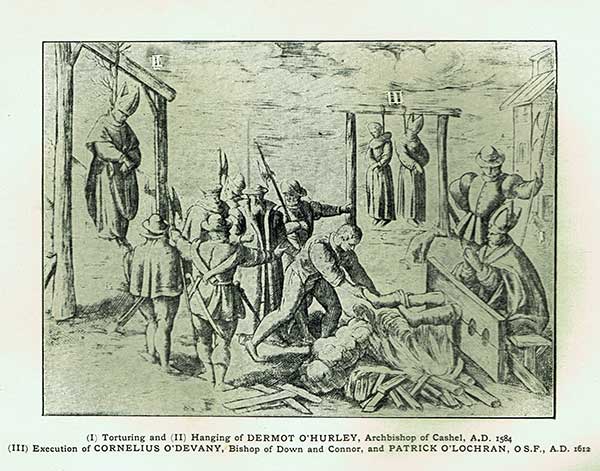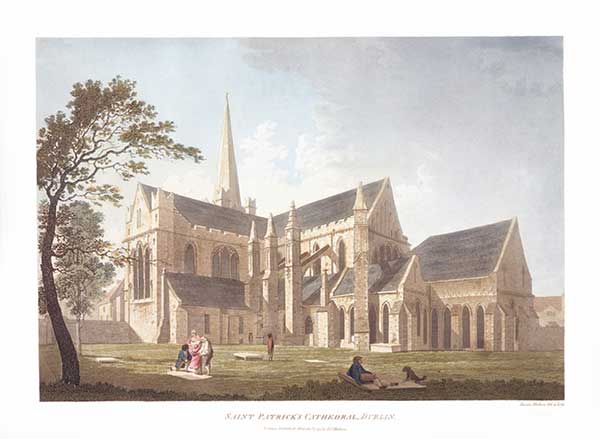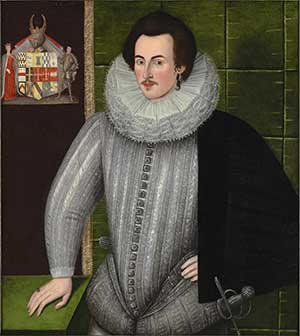Conversion by coercion?
Published in Issue 1 (January/February 2018), Platform, Volume 26The Reformation in Ireland.
By Henry A. Jefferies
Five hundred years after Luther unwittingly launched the Protestant Reformation, historians are still struggling to explain fully why his message resonated compellingly with some Christians but not with others. It failed to resonate to any significant degree among the Irish; contemporaries reckoned the number of Irish Protestants at between 40 and 120 individuals before the end of Elizabeth I’s reign. Yet a new book on the Church of Ireland argues that, with adequate resources and ‘coercion applied on a sufficient scale over a long enough period, this failure of the Reformation could have been reversed’.
Three contributors to The Church of Ireland and its past argue that the Reformation could have succeeded in converting the Irish to Protestantism if the English Crown had coerced them sufficiently. Karl Bottigheimer is particularly sanguine about the efficacy of coercion. He acknowledges that ‘there was a stunning lack of reformers in Ireland’, yet he claims that the Irish could have been coerced into becoming Protestants anyway: ‘in Bohemia persistent coercion ultimately defeated strong Protestant convictions’. A fundamental problem, however, with such counter-factual claims is that they are incapable of proof: one might as well claim that the Irish could have been converted to Protestantism if Jesus’s ‘Second Coming’ had happened as Martin Luther expected it to. Actually, the admission that the Reformation could have succeeded only if the English Crown had exercised a degree of coercion that was beyond its capabilities, practically and ideologically, is tantamount to an admission that the Reformation failed in Ireland. The ‘predestinarian’ beliefs prevalent among contemporary Protestants made the very notion of conversion through coercion anathema in any case.
Many years ago, when I was an assistant housemaster in a Church of Ireland boarding school, one of my duties was to help shepherd the boarders to the local church for the Sunday morning service. That experience left me dubious about the efficacy of obliging people to attend church services against their will. The Protestant Reformers preached a gospel of liberation and promised certainty of salvation for Christians with faith, for God’s elect. They would have regarded the notion that conversion could be achieved through coercion as a particularly perverse form of Pelagianism.
Bottigheimer cited the conversion of Bohemia to Catholicism in the seventeenth century as proof that conversion to Protestantism through coercion was possible in Ireland. The Bohemians, however, did not generally hold ‘strong Protestant convictions’, as Bottigheimer assumed. Most were Ultraquists, Christians who insisted that Jesus wanted His followers to receive wine as well as bread at communion. Despite the use of Czech as well as Latin in their church services, and the laity’s reception of communion in both forms, Ultraquists were formally in communion with Rome, rather like the Eastern-rite Catholic Churches or Uniate Churches. Their clergy were normally ordained by Catholic bishops as Catholic priests. Their shared beliefs and the ordination of their priests undoubtedly facilitated the subsummation of the Ultraquist Church into the Catholic Church in 1622. Recent research has revealed that the conversion of Bohemia was ‘less a product of violence and force than of negotiation and persuasion’.
No one has claimed that the failure of the Reformation in Ireland was inevitable since Brendan Bradshaw’s landmark publications from 1969. Nicholas Canny’s brilliant paper of 1979 on ‘Why the Reformation failed in Ireland: une question mal posée?’ extended the debate into Elizabeth’s reign by proposing that its failure was not definitive until long after the death of the last Tudor. For a young Church of Ireland scholar, as I then was, Canny’s work was inspirational: it suggested the real possibility that the Reformation could have succeeded in Ireland, and posed the challenges of defining how far it actually progressed and then of explaining why it ultimately failed.
Detailed work, on the records of the dioceses of Armagh and Dublin in particular, has shown that the official reforming policies of Henry VIII and Edward VI were implemented in the Pale and in some outlying areas to quite a striking degree. As late as Edward’s reign there is a little evidence that hints at the possibility that the Reformation might have succeeded in Ireland. Two ‘straws in the wind’ seem particularly telling. First, John Bale, the fiery former English friar turned Protestant bishop of Ossory, was able to win a remarkable following for the ‘Word of God’ among the young men of Kilkenny during his brief ministry in the city in 1553. Second, George Dowdall, the Palesman ‘papist’ who became the archbishop of Armagh at the hands of Henry VIII in 1543, went into exile in 1551 despairing for the future of Catholicism in Ireland. Had Edward VI lived for as long as might have been reasonably expected, it is conceivable that Protestantism could have struck enduring roots in Ireland, but he died in 1553 aged only fifteen. The number of Irish Protestants was still so small by that stage that trying to identify any of them is akin to a game of ‘Where’s Wally?’

Above: The savage torture of Dermot O’Hurley, archbishop of Cashel (1581–4), failed to coerce him into becoming a Protestant and he was hanged. Some historians claim that the Reformation could have succeeded with more coercion!
Because there was no ‘Irish Reformation’ as such but simply the extension to parts of Ireland of religious policies designed by a series of Tudor monarchs, the Reformation in Ireland is best studied within a wider Tudor-dominions framework. Comparisons show that the critical difference between England and Ireland was that key aspects of the Reformation resonated with a number of English people from the start, whereas there is no evidence that they resonated among the Irish. Peter Marshall reminds us that the first ‘Protestants’ in England used to be Catholics and that ‘[W]hat they were saying, and how they said it, resonated in challenging ways with what Catholic Christians already understood to be true’. Without them there would have been no Protestant Reformation in England: Henry VIII and his Protestant children could not have changed the religion of the English by themselves.
One may speculate that the Reformation did not resonate in Ireland as it did in England because of the absence of a university, as well as a lack of discernible engagement with humanist scholarship, along with the absence of an established market for the sale of printed books or pamphlets, which hampered the diffusion of new theologies. One might speculate, too, that the renewal of the Irish Church over the course of the century before the Reformation, reflected by the burgeoning of the mendicant orders and the wide-scale building of new parish churches, helped to satisfy the kind of desire for renewal that made many in England receptive to Evangelical calls for Reformation. In the event, when Elizabeth I had the English and Irish parliaments endorse her religious settlement in 1559 and 1560 respectively there was enough support in England to transform her ecclesiastical legislation into a true Reformation, while in Ireland there wasn’t.
Bottigheimer acknowledges that there was ‘a stunning lack of reformers in Ireland’, but he declares that the ‘absence of indigenous reform-minded clerics need not have been an insuperable obstacle’. The point, however, is that there was a ‘stunning lack of reformers’ of any nationality in Ireland. In 1565 Elizabeth I was informed that the only Protestant preachers in all of Ireland were two bishops of the Church of Ireland and a vicar visiting from Greenwich! By the end of the sixteenth century that tally had increased to 24 preachers, most of whom were chaplains to the English army! Without preachers, and without the widespread sale and distribution of Protestant books and pamphlets, the Reformation was stymied in Ireland from the start. It would be naïve to imagine that one had only to coerce people into attending the Church of Ireland’s services in order to convert them into Protestants, especially when it employed very, very few preachers and most of its services were read from a Latin translation of the Book of Common Prayer!

Above: St Patrick’s Cathedral, Dublin. In 1579 its dean, William Gerrard, had seats installed ‘for the nobility, for lawyers, for captains and all of the better sort, so as the citizens and all, being under his eye, never dare be absent’. The result, according to Lord Justice Pelham, was ‘a settled hatred and contrariety in religion settled’.
Elizabeth I had no police force or standing army with which to impose her will. She governed with the cooperation of the local élites in the shires and in the boroughs. In Ireland those élites did not cooperate with the imposition of the Elizabethan religious settlement. They generally refused to swear the Oath of Supremacy and would not enforce religious changes on the ground: Bishop Brady complained that they were ‘all thwarters and hinderers’ where the Reformation was concerned. Archbishop Loftus complained that the élites condemned her religious changes more manifestly than the rest. Royal officials told the queen that they dared not ‘meddle’ with the ‘multitude’ that rejected her Reformation.

Above: Parsonstown church, Co. Louth, was newly built on the eve of the Reformation but was allowed to fall into ruin by its parishioners as it was Protestantised, a common response to the Reformation in Ireland.
People responded to the introduction of the Book of Common Prayer in church services in Elizabeth’s reign by boycotting them. Whenever they were coerced into attending services against their will, many people disrupted them, acting as though they were at a ‘May game’. They chatted so loudly among themselves that the minister could hardly hear himself speak, and congregations walked around the churchyards while Protestant sermons were being delivered. Elizabeth established the Irish Ecclesiastical Commission in 1564 to coerce people into attending Church of Ireland services and not disrupt them. Yet her commissions were designed to deal with isolated dissidents, not well-nigh universal dissent. Boycotts and disruptions persisted. Fynes Morrison later reported that the coercion exercised by the Ecclesiastical Commission ‘wrought in their hearts a hatred of the government and in time a detestation of our religion’. He wrote that it was ‘more easy … to bring a bear to the stake than any one of them to our churches’.

Above: Lord Mountjoy, Elizabeth I’s last viceroy in Ireland—‘I am persuaded that a violent course therein [i.e. religious coercion] will do little good to win men’s consciences … I am of the opinion that all religions do grow under persecution’ (May 1603).
The build-up of an English military establishment facilitated the coercion of congregations in some Irish cities for a time in the middle of Elizabeth’s reign. In 1579 the leading men of Dublin were forced to sit through Church of Ireland services in St Patrick’s Cathedral, Dublin, something that one official remarked that he had never expected to see in his lifetime. The result, however, was a ‘settled hatred’ hatred’ among those coerced. The coercion was soon ended when a rebellion backed by Rome and Spain erupted later in 1579, for fear of fanning the flames of rebellion. In fact, the Crown’s wish to coerce the Irish into religious conformity was constantly tempered by the fear of provoking political unrest. When John Perrot, Elizabeth’s viceroy, sought to resume coercion in 1585, he was warned by the queen directly to desist from such provocative folly.
Much has been made of the fact that the Reformation seems to have struck a chord with some young men in Galway for a time in the 1580s. Nevertheless, dissent in the city persisted, despite heavy fines inflicted on heads of households under the aegis of the city’s garrison of English troops. No enduring community of indigenous Protestants was formed in the city. Wives and mothers played an important role in maintaining Catholicism in Galway and communicating it to their children, as women did elsewhere in Ireland. A Protestant mayor of Galway was married to a woman identified as the Catholic ‘ring-leader’ in the city. Margaret Ball was such a prominent Catholic in Dublin that her Protestant son, an alderman, had her imprisoned and, after her freedom was secured by Catholic sympathisers, he had her returned to prison and kept there until she died. Fynes Morrison records stories of Irish women pinching and starving Protestant spouses on their deathbeds to persuade them to return to the Catholic faith to avoid the fires of Hell.
In 1600 ‘an Irish native, well affectioned to religion’,wrote that there were plenty of well-endowed benefices in Ireland but only 120 native Protestants. The problem was not one of resources. He called for the ‘word of life’ and the ‘sword of death’ to promote the Reformation, to be applied by English preachers and English soldiers respectively. He reckoned that hanging a Catholic priest was as effective as killing 1,000 other people with swords or bullets. When the English army arrived in Derry in 1600 they killed the bishop of Derry and twenty local priests at one location, and others elsewhere. Soon after his arrival in Derry from England in 1606, George Montgomery, the first Protestant bishop of Derry, tried to silence the surviving Dominican friars by threatening them with death;months later the Dominican prior of Derryand his brother were executed. Another local friar was so badly tortured in 1608 that he was left crippled for the rest of his life. Yet, even with a Church of Ireland ministry that was generously resourced with endowments through the Ulster Plantation, such savage examples of coercion did not convert the indigenous population into Protestants. One can only wonder how savage the coercion ought to have been for the Reformation to have succeeded in Ireland.
Henry A. Jefferies is aResearch Associate in History, Ulster University.
FURTHER READING
- Empey, A. Ford & M. Moffitt (eds), The Church of Ireland and its past (Dublin, 2017).
- H.A. Jefferies, The Irish Church and the Tudor reformations (Dublin, 2010).
- H.A. Jefferies, ‘Why the Reformation failed in Ireland’,Irish Historical Studies158 (2016).
- Louthan, Converting Bohemia: force and persuasion in the Catholic Reformation (Cambridge, 2011).
















